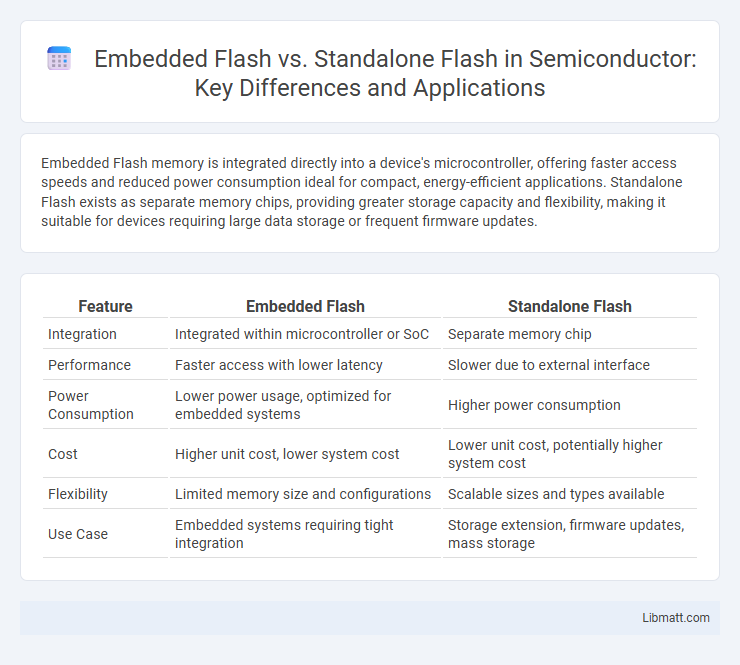Embedded Flash memory is integrated directly into a device's microcontroller, offering faster access speeds and reduced power consumption ideal for compact, energy-efficient applications. Standalone Flash exists as separate memory chips, providing greater storage capacity and flexibility, making it suitable for devices requiring large data storage or frequent firmware updates.
Table of Comparison
| Feature | Embedded Flash | Standalone Flash |
|---|---|---|
| Integration | Integrated within microcontroller or SoC | Separate memory chip |
| Performance | Faster access with lower latency | Slower due to external interface |
| Power Consumption | Lower power usage, optimized for embedded systems | Higher power consumption |
| Cost | Higher unit cost, lower system cost | Lower unit cost, potentially higher system cost |
| Flexibility | Limited memory size and configurations | Scalable sizes and types available |
| Use Case | Embedded systems requiring tight integration | Storage extension, firmware updates, mass storage |
Introduction to Embedded Flash and Standalone Flash
Embedded Flash is memory integrated directly into a microcontroller or system-on-chip (SoC), providing fast access and reducing the need for external components. Standalone Flash, on the other hand, exists as an independent memory chip that connects externally to a microcontroller or processor, offering larger storage capacity and flexibility for diverse applications. Choosing between embedded and standalone flash impacts your device's speed, power consumption, and design complexity.
Key Differences Between Embedded and Standalone Flash
Embedded flash memory is integrated directly onto a microcontroller or system-on-chip (SoC), offering faster access speeds and lower power consumption. Standalone flash is a separate memory chip connected via an interface such as SPI or NAND, providing higher storage capacity and greater flexibility for upgrades. Your choice depends on the need for integration, speed, storage size, and system design constraints.
Architecture Overview: Embedded Flash
Embedded Flash integrates non-volatile memory directly within a microcontroller or system-on-chip (SoC), enabling faster data access and lower power consumption due to reduced latency and minimized inter-component communication. This architecture enhances system efficiency by combining processing and storage capabilities on a single silicon die, which optimizes overall device footprint and cost. Your applications benefit from improved speed and reliability compared to Standalone Flash, which exists as a separate memory chip requiring external interfacing.
Architecture Overview: Standalone Flash
Standalone flash memory features a dedicated semiconductor chip designed for non-volatile data storage, separate from the main processor or system-on-chip (SoC). This architecture allows for higher storage capacities and specialized interface protocols, such as SPI or NAND, optimized for robust data retention and faster access speeds. Standalone flash typically supports advanced error correction and wear leveling algorithms, enhancing reliability and lifespan compared to embedded flash solutions.
Performance Comparison: Speed and Efficiency
Embedded Flash provides faster access speeds due to its close integration with the microcontroller, enabling lower latency and reduced power consumption compared to Standalone Flash. Standalone Flash typically offers higher storage capacity but at the cost of slower data transfer rates and increased energy use because of external communication interfaces. Performance efficiency in embedded systems is often optimized by leveraging Embedded Flash's superior speed and tighter system coupling, crucial for real-time applications.
Storage Capacity and Scalability
Embedded Flash typically offers lower storage capacity, ranging from a few megabytes to several gigabytes, limiting scalability for large data applications. Standalone Flash devices provide significantly higher capacities, often reaching terabytes, enabling extensive data storage and easier scalability through modular expansion. The choice between embedded and standalone Flash depends on the required storage size and the system's ability to scale over time.
Application Areas and Use Cases
Embedded Flash is widely used in consumer electronics, automotive systems, and IoT devices where integration and space-saving are critical, enabling firmware storage and fast access in microcontrollers and system-on-chips. Standalone Flash is preferred in applications requiring larger storage capacity and higher endurance, such as data backup solutions, SSDs, and industrial memory modules. Both technologies serve distinct roles in memory solutions, with Embedded Flash targeting compact, integrated designs, while Standalone Flash supports extensive data storage and high-performance needs.
Cost Implications: Development and Production
Embedded flash memory reduces production costs by integrating storage directly into the microcontroller or system-on-chip, minimizing the need for additional components and simplifying the assembly process. Standalone flash requires separate packaging and interfaces, which increases material costs and assembly complexity, leading to higher production expenses. Development costs for embedded flash may rise due to specialized design requirements and testing, whereas standalone flash benefits from standardized modules that streamline development and validation.
Security Considerations in Both Flash Types
Embedded flash memory offers enhanced security through close integration with the system-on-chip (SoC), enabling hardware-based encryption and secure boot processes that reduce vulnerability to physical attacks. Standalone flash typically requires external security measures, such as secure controllers or encryption modules, since it lacks inherent hardware security features. Both types must address risks like data remanence and firmware tampering, but embedded flash's tighter coupling with the processor often results in stronger protection against unauthorized access and reverse engineering.
Choosing the Right Flash Solution for Your Project
Choosing the right flash solution for your project depends on factors like storage capacity, speed, and integration requirements. Embedded flash offers seamless integration with microcontrollers, reducing latency and saving board space, ideal for compact designs needing fast access. Standalone flash provides higher storage capacities and flexibility, suitable for applications requiring extensive data logging or firmware updates.
Embedded Flash vs Standalone Flash Infographic

 libmatt.com
libmatt.com